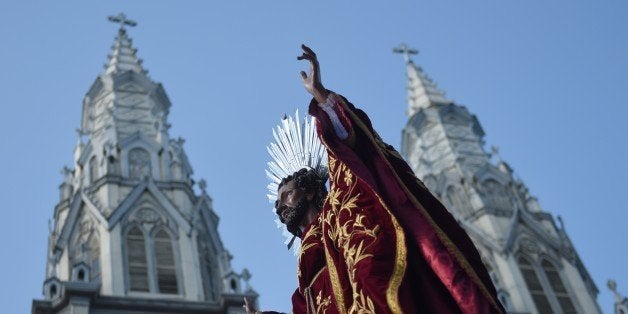
In their landmark book, Manufacturing Consent, Noam Chomsky and Edward S. Herman devote a chapter to the media's unbalanced coverage of the murder of one priest in Poland in 1984 as compared to the coverage of the 72 religious killed throughout Latin America between 1964 and 1978, the killing of 23 religious in Guatemala between 1980 and 1985, the murder of Archbishop Oscar Romero of San Salvador in 1980 and the rape and murder of the 4 U.S. Church women in El Salvador in 1980. In short, the murder of the one Polish priest -- the perpetrators of which were actually tried, convicted and sentenced to prison -- received significantly more coverage than all of the latter killings, which largely remain unsolved and unpunished, combined.
Of course, the reason for the disparity in coverage is that the Western media invariably fixates on the crimes of others while ignoring our own crimes. In this case, the media focused on the murder of one priest in then-Communist Poland while largely ignoring the scores of priests killed by right-wing governments aligned with and supported by the United States.
Fast forward to the present when the National Catholic Reporter (NCR) has just reported on the extradition order for Col. Inocente Orlando Montano to be tried for his role in the murder of six (6) Jesuit priests, along with their housekeeper and her daughter, in El Salvador on November 16, 1989. Montano is being extradited to Spain from the U.S. where he has been comfortably sheltered for years. As the NCR reported:
In her 23-page ruling, [Judge] Swank said the evidence shows that Montano participated in the "terrorist" murders and attended the key meetings where the high command plotted the assassination of Jesuit Father Ignacio Ellacuría, the rector of the University of Central America.
Ellacuría was also serving as a key negotiator trying to mediate a peace between the US-backed Salvadoran government and the Farabundo Martí National Liberation Front (FMLN.) The peace talks included discussions about purging the military of those officers linked to atrocities.
The operation to eliminate Ellacuría and all witnesses was carried out Nov. 16, 1989 by a US-trained anti-terrorist unit, which stormed the Central American University in San Salvador and blew out the brains of the Jesuits with high-powered weapons. The assassins then executed their housekeeper, Julia Elba Ramos, and her daughter Celina.
(emphasis added).
The NCR notes that Montano "was also trained at the U.S. Army School of the Americas (SOA) at Fort Benning, Ga., now known as the Western Hemisphere Institute for Security Cooperation." (emphasis added)
That Montano, a murderer of Catholic priests, was trained at the SOA makes perfect sense, for the SOA -- which continues to train thousands of repressive Latin American military forces -- has itself bragged about its role in destroying Liberation Theology (the Christian philosophy which advocates "the preferential treatment for the poor") in Latin America. As Noam Chomsky has explained, "[o]ne of its advertising points is that the U.S. Army [School of the Americas] helped defeat liberation theology, which was a dominant force, and it was an enemy for the same reason that secular nationalism in the Arab world was an enemy -- it was working for the poor."
And, the SOA specifically encouraged the violent assault on priests, as Jack Nelson-Pallmeyer notes in his book, School of Assassins. Thus, as he explains, 75 percent of the training exercises at the SOA ended with the priest or other religious figure (usually played by a U.S. army chaplain) either killed or wounded.
As Noam Chomsky has noted elsewhere, the U.S.'s military campaign in Latin America since 1962
was in substantial measure a war against the Church. It was more than symbolic that it culminated in the assassination of six leading Latin American intellectuals, Jesuit priests, in November 1989, a few days after the fall of the Berlin wall. They were murdered by an elite Salvadoran battalion, fresh from renewed training at the John F. Kennedy Special Forces School in North Carolina. As was learned last November, but apparently aroused no interest, the order for the assassination was signed by the chief of staff and his associates, all of them so closely connected to the Pentagon and the US Embassy that it becomes even harder to imagine that Washington was unaware of the plans of its model battalion. This elite force had already left a trail of blood of the usual victims through the hideous decade of the 1980s in El Salvador, which opened with the assassination of Archbishop Romero, "the voice of the voiceless," by much the same hands.
The murder of the Jesuit priests was a crushing blow to liberation theology, the remarkable revival of Christianity initiated by Pope John XXIII at Vatican II, which he opened in 1962, an event that "ushered in a new era in the history of the Catholic Church," in the words of the distinguished theologian and historian of Christianity Hans KŸng. Inspired by Vatican II, Latin American Bishops adopted "the preferential option for the poor," renewing the radical pacifism of the Gospels that had been put to rest when the Emperor Constantine established Christianity as the religion of the Roman Empire -- "a revolution" that converted "the persecuted church" to a "persecuting church," in KŸng's words. In the post-Vatican II attempt to revive the Christianity of the pre-Constantine period, priests, nuns, and laypersons took the message of the Gospels to the poor and the persecuted, brought them together in "base communities," and encouraged them to take their fate into their own hands and to work together to overcome the misery of survival in brutal realms of US power.
Thankfully, the U.S.'s reprehensible campaign abroad to wipe out true Christianity -- as opposed to the bizarre brand predominating in the U.S. which has strangely substituted a false Christ-the-Destroyer for Christ-the-Carpenter -- has not been completely successful, with Liberation Theologians indeed taking credit for helping give rise to Pope Francis and his emphasis on poverty issues.
Still, much damage has been done, and many lives lost, as the result of a military program which has persecuted the Church in the name of defending it against "godless Communism." That we as a nation have allowed this to go on is cause for profound self-reflection and atonement, though, thanks to a supplicant mainstream press, few will ever know that any of this has transpired.
